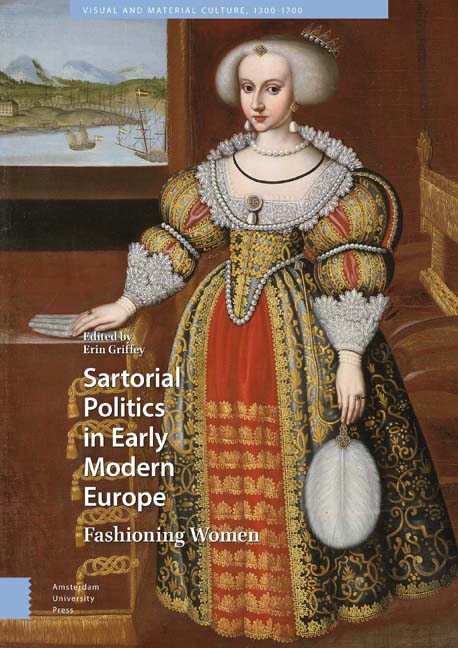Book contents
- Frontmatter
- Acknowledgements
- Contents
- List of Illustrations
- Introduction
- 1 Isabella d’Este's Sartorial Politics
- 2 Dressing the Queen at the French Renaissance Court: Sartorial Politics
- 3 Dressing the Bride: Weddings and Fashion Practices at German Princely Courts in the Fifteenth and Sixteenth Centuries
- 4 Lustrous Virtue: Eleanor of Austria's Jewels and Gems as Composite Cultural Identity and Affective Maternal Agency
- 5 Queen Elizabeth: Studded with Costly Jewels
- 6 A ‘Cipher of A and C set on the one Syde with diamonds’: Anna of Denmark's Jewellery and the Politics of Dynastic Display
- 7 ‘She bears a duke's revenues on her back’: Fashioning Shakespeare's Women at Court
- 8 How to Dress a Female King: Manifestations of Gender and Power in the Wardrobe of Christina of Sweden
- 9 Clothes Make the Queen: Mariana of Austria's Style of Dress, from Archduchess to Queen Consort (1634–1665)
- 10 ‘The best of Queens, the most obedient wife’: Fashioning a Place for Catherine of Braganza as Consort to Charles II
- 11 Chintz, China, and Chocolate: The Politics of Fashion at Charles II's Court
- 12 Henrietta Maria and the Politics of Widows’ Dress at the Stuart Court
- Works Cited
- Index
9 - Clothes Make the Queen: Mariana of Austria's Style of Dress, from Archduchess to Queen Consort (1634–1665)
Published online by Cambridge University Press: 21 November 2020
- Frontmatter
- Acknowledgements
- Contents
- List of Illustrations
- Introduction
- 1 Isabella d’Este's Sartorial Politics
- 2 Dressing the Queen at the French Renaissance Court: Sartorial Politics
- 3 Dressing the Bride: Weddings and Fashion Practices at German Princely Courts in the Fifteenth and Sixteenth Centuries
- 4 Lustrous Virtue: Eleanor of Austria's Jewels and Gems as Composite Cultural Identity and Affective Maternal Agency
- 5 Queen Elizabeth: Studded with Costly Jewels
- 6 A ‘Cipher of A and C set on the one Syde with diamonds’: Anna of Denmark's Jewellery and the Politics of Dynastic Display
- 7 ‘She bears a duke's revenues on her back’: Fashioning Shakespeare's Women at Court
- 8 How to Dress a Female King: Manifestations of Gender and Power in the Wardrobe of Christina of Sweden
- 9 Clothes Make the Queen: Mariana of Austria's Style of Dress, from Archduchess to Queen Consort (1634–1665)
- 10 ‘The best of Queens, the most obedient wife’: Fashioning a Place for Catherine of Braganza as Consort to Charles II
- 11 Chintz, China, and Chocolate: The Politics of Fashion at Charles II's Court
- 12 Henrietta Maria and the Politics of Widows’ Dress at the Stuart Court
- Works Cited
- Index
Summary
Abstract
This chapter analyses the outfits worn by Mariana of Austria (1634–1696), archduchess and queen consort of Spain, as depicted in portraits. Archduchesses were political figures whose marriages strengthened the Viennese court's relations with other European powers. This chapter charts Mariana´s portraits from her engagement portrait in Germanic attire, which symbolised her dynastic capital at the Spanish court of Baltasar Carlos. His sudden death led to his father, Felipe IV, becoming a suitor and another strategically staged portrait. Her move to Madrid in 1649 led to radical changes in her dress, with the adoption of the farthingale. Mariana ultimately made the farthingale her own, endowing it with new meaning and turning it into an expression of her authority as queen consort.
Key words: Mariana of Austria; image; dress; fashion; farthingale
Mariana of Austria, daughter of Holy Roman Emperor Ferdinand III and Empress Maria Ana of Austria, married her uncle King Felipe IV by proxy in 1648, and arrived in Spain in November 1649. Madame d’Aulnoy, a French noblewoman, noted the following event in Mariana's journey to the Madrid court: in a town near Madrid, a hosier approached the young Mariana to offer her some tights. The First Steward found the gift so unseemly that he threw them to the ground, shouting ‘You should know that Queens of Spain have no legs!’, meaning they were of such high standing that they floated above everyone else. According to the Countess d’Aulnoy, Mariana of Austria interpreted the words of her steward literally and began to sob, believing her legs would be removed when she arrived at the Spanish court.
Madame d’Aulnoy recorded this anecdote in the memoirs of the trip to Spain she made in 1679 and wrote this text in 1690, four decades after this supposed episode took place. The historians Gabriel Maura and Gonzalez de Amezua concluded that the French lady did visit Madrid on those dates but that the truth of the events recorded in her memoirs is highly questionable. Madame d’Aulnoy probably heard this anecdote in Madrid and transcribed it literally eleven years later, without considering whether it was true. It is highly likely that this story was part of the myths told about the Austrian wives in Spain.
- Type
- Chapter
- Information
- Sartorial Politics in Early Modern EuropeFashioning Women, pp. 207 - 226Publisher: Amsterdam University PressPrint publication year: 2019

